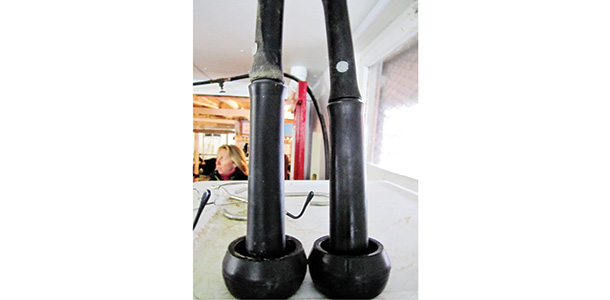What do you see? This is a very simple phrase, but it is very difficult for many people to really “see” when they walk through a parlor, barn or a complete dairy facility. It takes effort to train yourself to look past the obvious, to see things that can have a direct impact on milk production and milk quality.
Unfortunately, on many dairies, “the abnormal becomes normal.” Most often this is expressed as abnormal behavior in the parlor caused by either neglected milking equipment maintenance, improper installation or adjustments of components such as milk hoses, improper settings of the milking equipment, lack of consistency or improper timing by milk harvest technicians during the udder preparation process.
Milk quality is often discussed by looking at three key areas: the cows, the people and the milking equipment. Often small, low-cost changes can be made in each of these three areas with significant changes in milk quality and overall milkability.
The cows
Many dairy owners, dairy managers and even parlor managers fail to monitor cow behavior on a regular basis. Observing cows should be a daily routine, but it is often hard for people to take the time to monitor cow behavior when they feel they should be doing other more important tasks on the dairy.
Abnormal behavior in the parlor or barn results in milk harvest technician frustration and lower milk production.
When observing cows in the parlor, always ask the following questions and make these observations:
1. How do the cows enter the parlor?
2. How do cows stand once they are in the parlor?
• During udder prep?
• At unit attachment?
• Toward the end of milking?
• At unit detachment?
3. What is the appearance of cows’ teats at unit detachment?
• What is the level of teat ringing?
4. How many teats are discolored, either purple or red, or have obvious white lines across the end of the teats from liners?
5. How much milk can be obtained immediately after the units are detached by hand-stripping, and what is the behavior of the cows during the stripping?
6. How do cows leave the parlor after milking is completed?
7. How much manure is deposited in the parlor for each shift or milking?
The people
The No. 1 people observation is to monitor the consistency of the parlor procedures and routine. Procedures are defined as the steps that it takes to milk one cow. The routine is how multiple cows are milked in the parlor.
Examples would be cows prepped in groups, where one milk harvest technician handles all of the procedures for the cows in the group; a territorial routine, where one milk harvest technician handles all procedures in a certain area of the parlor; or a sequential routine, where milk harvest technicians follow one another down the side of the parlor performing various procedures.
Better consistency in timing is typically achieved with either the group or territorial routines compared to the sequential routines. The goals of udder preparation are relatively simple and are designed to take advantage of the physiology of the milk cow.
It requires 10 to 12 seconds of teat contact time to stimulate oxytocin letdown, followed by attaching the unit at approximately 90 seconds or slightly longer from the time the first teats are touched. The No. 1 issue on many dairies is achieving those two goals on a milking-to-milking basis.
The following are questions to help understand the procedures and routine:
1. How long does it take cows to move from the entry gate to the front stall in the parlor?
2. How long does a cow stand in this first stall before a milk harvest technician begins to perform the first step of the udder preparation routine?
3. Do all milk harvest technicians follow the written protocol? Do they always start at the right cow?
4. If pre-dipping is used, how good is the pre-dip coverage?
5. What is the percentage of cows leaving the parlor without having complete teat coverage?
6. Are teat ends clean when units are attached?
• Check teat-end cleanliness with alcohol pads or cotton balls soaked in alcohol just before units are attached. How clean are these for each milking crew?
7. How clean are the filter socks?
8. Do the milk harvest technicians “think clean” during udder preparation?
• Do technicians always wear gloves?
• Do technicians use drop hoses to clean units when necessary?
• Do technicians follow the procedures for cleaning the parlor, such as washing the platforms when cows are not present, washing the entrance area between pens or groups and washing units at the end of every group?
• Are technicians’ apron pockets for towels clean?
• Are clean towels transported and stored in clean containers?
• Are pre-milking and post-milking teat dippers clean and free of organic debris?
• If specialized udder preparation aids are used, are they also maintained in a sanitary condition? (Example: Foamers or mechanical brush systems – are the brushes in good condition?)
• Are any teat dip transfer containers properly cleaned, and do they have covers at all times?
• Do the milk harvest technicians have the proper equipment to maintain the parlor properly during milking?
• Are all drop-hose nozzles maintained in good condition?
• Are there squeegees available?
• Are there proper storage areas for dip cups, sprayers and foamers strategically located in the parlor?
• Are trash cans used in the parlor, and is the parlor free of trash, i.e., used gloves, etc.?
The milking equipment
The milking equipment is the most important machine on any dairy farm. However, routine maintenance and scheduled parts replacement is rarely followed according to manufacturers’ recommendations. The consequence of poor milking equipment maintenance is reduced performance.
Some producers will argue that they have maintained low somatic cell counts and low clinical mastitis cases when they are informed about maintenance issues on their dairy; therefore the milking equipment is performing properly.
Low bulk tank somatic cell counts and low clinical mastitis rates only mean that teats are clean when units are attached. Improperly performing milking equipment can and does cost milk production, even when clean, dry, stimulated teats are being milked.
The mastitis new infection rate is directly related to the number of bacteria on teat skin when units are attached. The number of bacteria on teat skin is also related to the teat skin and teat end condition, which is dramatically impacted by milking equipment.
The typical dairy will either pay for scheduled parts replacement now or pay later due to higher clinical mastitis and bulk tank somatic cell count levels or with lost milk from unscheduled downtime.
Producers should work with their equipment suppliers to develop a system maintenance schedule based on the number of cows being milked and the size of the milking parlor or barn on their facility.
Maintaining a calendar in the farm office or some other convenient location on the dairy to record all system maintenance is a good way to monitor compliance with the scheduled service program.

Typically the most neglected components of the milking equipment are the rubber goods. These include the overuse of inflations, short air tubes, milk hoses, jetter cups, duckbills, wash line hoses and gaskets throughout the milking system.
New inflations or liners do not require a break-in period. If cows milk differently when liners are changed, then one of two things is an issue for the dairy.
Either the number of wash cycles has exceeded 90 cycles for North American liners or 180 cycles for European formula liners, or the chlorine levels in the wash solutions are too high and are impacting the life of rubber liners.
The following are questions to help evaluate the condition of the milking equipment and system maintenance.
1. What is the liner change interval? Evaluate used and new liners.
• Evaluate new cases of mastitis around liner changes.
2. What is the milk path from the claw outlet to the milk line?
• Are there any restrictions at any pinch valves?
• What is the condition of any gaskets in the claws?
• Are the claw bleed holes open or plugged?
• If stainless claws are being used, what is the condition of the ferrules?
• What is the condition of any gaskets where the milk hose attaches to the milk line?
• What is the condition of the short air tubes from the diverter on top of the claw to the shells?
• If the system has a shut-off valve other than a pinch valve, what is the condition of the diaphragm and the supply hoses to the sensor shutoff valve?
• What types of unit alignment devices are being used? Can units be adjusted to hang squarely underneath all four teats without restricting milk flow away from the cow?
3. What is the length of the milk hoses and long pulsation hoses along with their condition?
4. What are the conditions of any filtered air filters? Are the covers intact with no cracks?
5. What condition are the gaskets at moisture traps, receiver jar lids, at diverter valves and milk line gaskets?
6. If milk meters are present, what is the condition of any rubber gaskets or diaphragms? How often are they being rebuilt?
7. How often are pulsators being rebuilt? How often are pulsators being graphed?
8. What are the conditions of the wash system components, i.e., duckbills, gaskets, hoses, etc.?
9. How well do the retraction cylinders work if there is automation present in the parlor?
Summary
Taking the time to routinely walk through the parlor or milking barn to make observations about cows, people and equipment will pay benefits for the dairy.
Working with the local equipment dealer is very important to set up a well-designed parts replacement, system maintenance and testing program to ensure optimal milk harvest over time.
Observing what is happening in the parlor or barn and thinking of the listed questions will help to ensure long-term performance and optimization of both milk harvest and milk quality. PD
PHOTO
Typically the most neglected components of the milking equipment are the rubber goods. Photo courtesy of David Reid.

David Reid
Rocky Ridge Dairy Consulting, LLC







